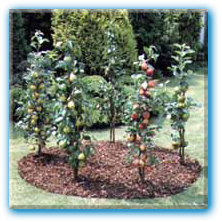How to Select, Plant, and Care
for Fruit Trees
| No home grounds, whether large or
small, should be without fruit trees. Growing fruit can be a educational and enjoyable
experience. There is nothing like fresh fruit
on the table. Home-grown fruit, like home cooking, full of natural vitamins, is by far the
best. Tree-ripened fruit is esteemed for its juiciness, delicacy, and richness of flavor.
Unless you can enjoy ripe fruit from your grounds, you will never know what fresh fruit
has to offer.
The climate conditions of the United States vary
greatly, and the conditions of the area in which you live should be recognized before you
plant fruit trees. |
 |
All fruit trees have a chilling requirement that is
necessary in order for them to blossom and fruit. In general, a dormant period of 45 days,
with temperatures of 45 or less, is needed. Extremely cold winter temperatures over a long
period kill blossom buds. The apple is the most hardy and is generally resistant to
-25°F, the peach and nectarine are least hardy and suffer blossom bud damage at -12° to
-15°F. After the apple, the plum is next hardiest, followed by the European plum, sour
cherry, sweet cherry, Japanese plum and the apricot, which is about as hardy as the peach.
Soils should drain water properly, and water should
not stand on top of ground for more than one week after a heavy rain. The level of normal
ground water should not be within three feet of the surface. The optimum pH of the soil
should be in the range of 6 to 6.5.
Fruit trees may be planted in the spring or fall.
Fall planting has its advantages, in that, the soil is in better condition, the weather
conditions are better and the trees start growing earlier in the spring. In areas where
winters are severe, such as northern New England, it is better to plant in the spring.
| In choosing which varieties of a type
of fruit to grow, there are many considerations. We are all familiar with the varieties
found in the supermarket. These are the commercial varieties found in the supermarket.
These are commercial varieties of fruit that are easiest for the commercial fruit grower
to raise and ship. In most cases, these fruits are not picked at the height of full
flavor; a similar variety grown in the garden will taste superior. There are varieties
that are not so well known, either because they are new or because they are not grown
commercially. Most of the old time varieties have characteristics such as poor color or
unpleasant appearance. However, their flavor quality are ideal for the home fruit grower.
Aside from taste and appearance, some varieties, old or new, are more adaptable than
others to severe situations such as cold winter temperatures. These varieties should be
your first choice. |
 |
The common types of fruit do not come true from
seed. and it is necessary to propagate them by budding or grafting to a rootstock. The
rootstock controls the size and soil adaptability of the tree. One has to choose which
size is best suited for his needs.
The correct time to harvest fruits will vary from
year to year and is influenced by weather conditions during the growing season. Most
ripening times that are listed for fruit varieties are an approximation. It is best to
sample a few random fruits to find out if it is time to harvest the fruit.
The home gardener has many advantages over
commercial grower in raising fruit. Since only a few trees are planted, the gardener can
select sheltered areas on his property, pay closer attention to growth of the trees, and
make easier adjustments to drainage, fertility, and protection.

